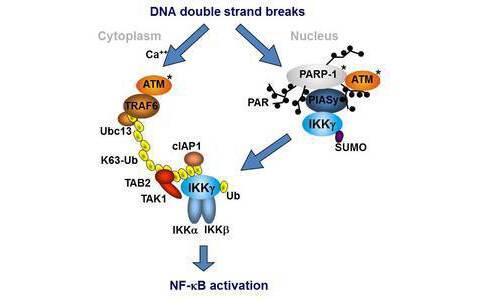
Scheidereit Lab
Signal Transduction in Tumor Cells (Emeritus)
DNA damage induced NF-κB signaling
Metabolic and external DNA-damaging agents, such as ionizing radiation, toxic chemicals and free radicals, constantly endanger the genomic integrity of cells. To counter these threats, mammalian cells have developed a network of DNA damage response pathways. DNA lesions are recognized by several independent molecular complexes, which in turn initiate DNA repair, cell cycle checkpoint control and the activation of transcription factors such as NF-κB and p53. While p53 induces cell-cycle arrest or apoptosis NF-κB triggers cell survival and may counteract apoptotic action of genotoxic therapy. However, it could be demonstrated that NF-κB activation by chemotherapy can also be beneficial through the induction of a senescence-associated secretory phenotype. Thus, further elucidation of NF-κB pathway components is important to better understand cell fate decision processes, related to cancer therapy.
Model of IKK and NF-κB activation upon genotoxic stress
We and others could demonstrate that genotoxic stress triggers two corresponding signaling axis to activate the IκB kinase (IKK) complex analogously to the canonical NF-κB signaling cascades (Figure 2). The first axis is initiated by the DNA strand break sensor poly(ADP-ribose)-polymerase-1 (PARP-1), which sets up a transient nucleoplasmic complex and triggers PIASy mediated SUMOylation and most likely ataxia telangiectasia mutated (ATM) mediated phosphorylation of nuclear IKKγ. We assume that modified IKKγ shuttles back to the nucleus and assemble into new formed IKK complexes. At the same ATM translocates to cytoplasm, binds TRAF6 and triggers its K63-linked polyubiquitination. Activated TRAF6 recruits cIAP1 and TAB2-TAK1, resulting in TAK1 activation and IKKβ phosphorylation. However, final activation of the IKK complex requires IKKγ mono-ubiquitination of IKKγ at lysine 285, identified by “selected reaction monitoring” (SRM) mass spectrometry (MS). In ongoing studies, we investigate characteristics of the genotoxic pathway in vivo by bio-imaging, taking advantage of NF-κB luciferase reporter mice. Moreover, we are investigating how DNA damage induced IKKγ modifications contribute to NF-κB activation and search for further novel components in the signaling cascade. Last not least, we aim to understand the cross talk between p53 and NF-κB dependent transcriptional regulation.
Researchers
- Michael Hinz
- Marina Kolesnichenko
- Nadine Mikuda
- Michael Willenbrock
Collaborations
- Wei Chen (MDC)
- Gunnar Dittmar (MDC)
- Kum Kum Khanna (Queensland Institute of Medical Research)
- Markus Landthaler (MDC)
- Alexander Löwer (MDC)
- Clemens Schmitt (Charité)
- Valérie Schreiber (Université de Strasbourg)
- Jana Wolf (MDC)





